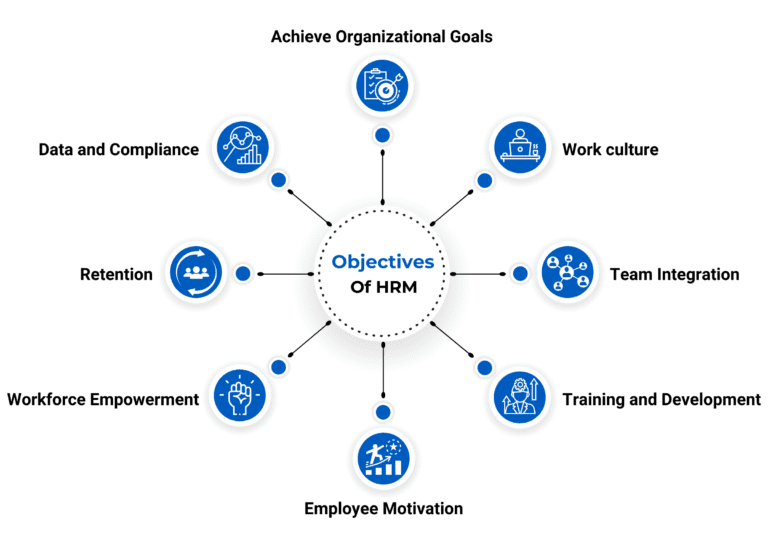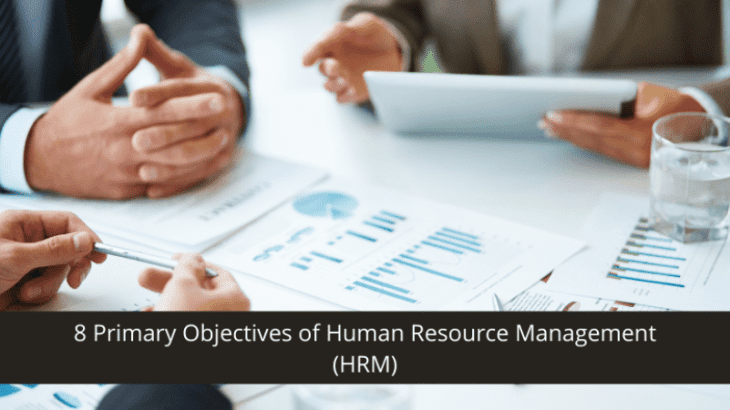What is HR Management?
Human resource management is basically the administration of human resources. It primarily refers to handling employees and acknowledging their requirements for maintaining a positive work culture.
The definition of HRM also includes a set of practices, which helps manage employee data like attendance, payroll, and ensuring smooth employment.
What is the Objectives of Resource Management?
The primary objective of resource management is to ensure a seamless experience for the staff and other people associated with management and organizational goals. Objectives of HRM include ensuring availability of resources, easy access to data, on-time payroll, ensuring compliances, etc.
HRM objectives are basically influenced by organizational goals and vertical. The objective of HRM is to ensure a stable work environment with data in one place and efficient operations.
What are HRM Organizational Objectives?
Below are 8 primary objectives of human resource management with in-depth elaboration respectively:
- Achieve organizational goals
- Work culture
- Team integration
- Training and Development
- Employee motivation
- Workforce empowerment
- Retention
- Data and compliance

Achieve Organizational Goals
HRM function starts here. One major HRM objective is to fulfil organizational goals. Utilizing human resources to achieve business requirements and goals is very important for an effective HRM.
Organizational objectives include workforce handling, staff requirements like hiring and onboarding, payroll management, and retirement. To succeed at the organizational objectives, HR requires efficient planning and execution. Without a set parameter for goals and mission and resources, HRM is incomplete. After you know your resources and planning at the place, achieving HRM objectives is not so difficult.
Some more objectives are explained further.
Work Culture
When it comes to handling HRM effectively and following objectives, employee and work environment are the prior factors. Work culture plays an important role in defining HRM and business performance.
An HR manager needs to be active while calling for strategies to foster better work culture. Automated activities like leave approvals, reimbursement request acknowledgement, etc. can help you. Quick operations and empowerment to employees help in creating positive vibes at the workplace. Developing and maintaining healthy and transparent relations among team members and teams contribute to building a good example of work culture. Adopting the right solutions like employee management software can solve more than half of your job.
Small steps like short and sound onboarding processes can help build a good image of the workplace.
Team Integration
One of the prime roles and objectives of HRM is to make sure the team coordinates efficiently. Easy communication is the need for teams at an enterprise. An HR here must ensure a tool to assist in making the integration easier and smooth.
The proper connection between individuals is a must to ensure productivity. To make HR management successful, you need to search for better integration portals to make data availability easier for people. Functional objectives like team integration are to produce streamlined operations and tasks.
A right tool like the self-service portal can bring employees closer to HR folks.
Training and Development
Workforce being effective and performing are two important and basic elements to work upon for achieving your basic objectives at an organization. With proper training and providing future opportunities, employees feel safe and organized.
Effective employment is highly dependent upon the training practices. Providing opportunities to employees is one great step to ensure workforce management.
There might be difficulties such as planning, scheduling, training sessions, and evaluation of each on-boards. To lessen the pain, solutions like training management software can help you with auto-reminders, easy scheduler, reporting, and tracking capability. The HR manager can ensure effective training practice at the firm.
Employee Motivation
The prime objective of HR folk is to keep things on the right path. Keep distractions and negative vibes away. For this, the employees need to be attended to and kept motivated throughout. How can HR motivate employees?
Give powers to them. Take their views on things. Involve them in weekly meets or decisions. Even if it is a fresher, let them join. Keep the morale always high. Employee recognition like yearly appraisal based on their performance can too help.
An automated feedback system for performance appraisal management can keep your employees motivated and ensure productivity throughout the service. When the employees are satisfied and fulfilled, nothing else can prevent you from losing your objectives and goals.
Workforce Empowerment
Talking about employee motivation, nothing can work better than empowering them. Empowering them with tools like ESS (employee self-service) portal can help save HR efforts too.
With the portal, employees can themselves apply for approvals and track them through their mobile phones. Be it leave request, generating payslip, checking PF account, remaining leaves, upcoming holidays, manager details, or anything, HR intervention is least required. Now, you no more need to knock on HR’s desk for small queries.
What else could empowering workforce take? How would you ensure the right workforce engagement? Effective HRM measures can definitely help. Look for easy employee management tips.
Retention
Providing leadership qualities and opportunities, a healthy working area, and employee retention are some prime objectives and deliverables of the HR managers. Keeping employees retained and motivated needs to be a top priority for HRM.
Other than employee hiring, onboarding, and training cycle, keeping the employees retained for long is the biggest challenge AKA objective of the HR people. It often occurs that employees leave the organization within 2 months of onboarding. It can be due to ineffective training management or a rough hiring process.
Employee experience needs to be carefully attended. Keeping your employees retained can help maintain a good state of employee turnover. To keep it stable, the HR manager needs to learn the best retention tips for business.
Data and Compliance
Functional and organizational objectives also include managing company/ employee data and managing compliances. Managing payroll compliances and keeping the company out of any penalties or fines is a huge challenge for HR people and managers.
Even a small error or miscalculation can owe you huge penalties and even may lose respect. When committing to tasks like employment and payroll, you need to be careful about laws and regulations. The objective here is to keep any unwanted claims at bay for smooth functioning.
Automated software like the HRMS system can help you keep errors at the side and leave no window for owing any penalty from IRS. It is the responsibility of HR to follow IRS guidelines and standards for effective employment at the company. Stay assured of all the legalities.







